【复旦大学 投资学】Section4 FamaEMH
复旦大学厦门大学金融学真题汇编
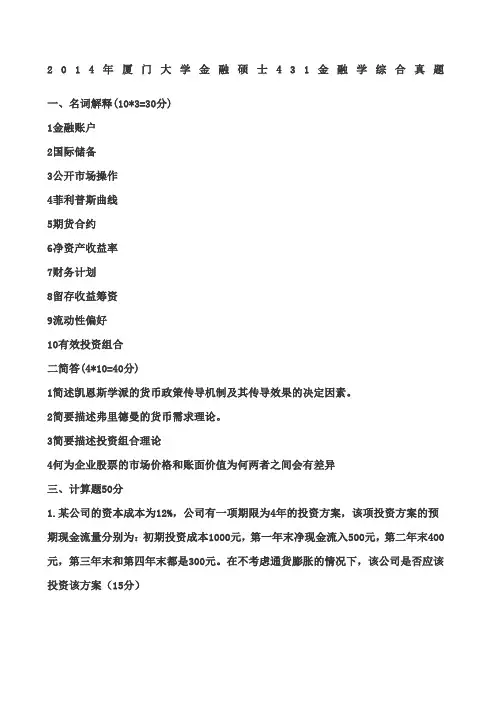
2014年厦门大学金融硕士431金融学综合真题一、名词解释(10*3=30分)1金融账户2国际储备3公开市场操作4菲利普斯曲线5期货合约6净资产收益率7财务计划8留存收益筹资9流动性偏好10有效投资组合二简答(4*10=40分)1简述凯恩斯学派的货币政策传导机制及其传导效果的决定因素。
2简要描述弗里德曼的货币需求理论。
3简要描述投资组合理论4何为企业股票的市场价格和账面价值为何两者之间会有差异三、计算题50分1.某公司的资本成本为12%,公司有一项期限为4年的投资方案,该项投资方案的预期现金流量分别为:初期投资成本1000元,第一年末净现金流入500元,第二年末400元,第三年末和第四年末都是300元。
在不考虑通货膨胀的情况下,该公司是否应该投资该方案(15分)2.某公司股票初期的股息为美元/股。
经预测该公司股票未来的股息增长率将永久性地保持在4%的水平。
假定贴现率为10%,那么,根据不变增长模型,该公司股票的内在价格是多少10分3假设公司2009年的净收益是200万元,2009年末的总资产为4500万元,并且假设公司有个确定的要求:保持债务/权益的比例为,公司经理不能借款或发行股票。
请问:(1)公司最大的可持续增长率是多少(2)假如公司将净收益中的100万元作为股利,并且计划在将来保持这种支出比例,现在公司的最大可持续增长率是多少(15分)4有一张两年内到期的债券,其票面价值为1000元,票面利率为4%,当前的价格是950元,请计算这张债券的当前收益率和到期收益率。
(10分)四.论述题(15分×2=30分)1.你认为我国金融市场有哪些跟发达国家不同的现象你对这些现象有什么样的解释2据《中国证券报》报道,相关各方已就我国民营银行试点的有关事宜达成一致,业内人士预计,入围首批试点的民营银行的牌照最快于2014年年初“出炉”.民营银行的发展是我国银行业改革的大趋势,但我国政府需要采取何种政策来规避银行业的风险面对即将异军突起的民营银行,传统商业银行要如何应对日益激烈的市场竞争2013年厦门大学金融硕士431金融学综合真题一、名词解释(10*3=30分)1.经常帐产2.国际储备3.公开市场操作4.货币乘数5.看涨期权6.资产负载表7.货币政策8.金融危机9.净现值10.抵押债券二、简答(4*10=40分)1.试简述普遍股和优先股的差异。
投资学第六章组合投资与资产定价
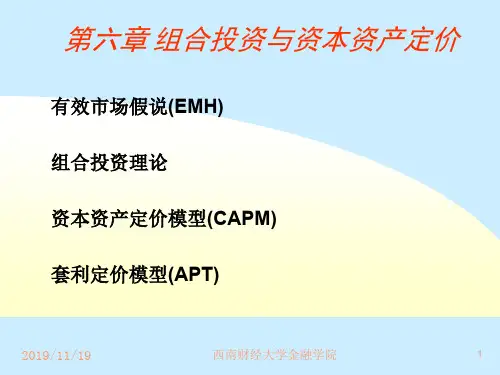
一、单一资产的收益与风险
2、原则: 在风险既定的条件下,获得最大的收益。 在收益既定的条件下,承担最小的风险。
2019/11/19
西南财经大学金融学院
17
一、单一资产的收益与风险
(二)单一资产的收益
1、一般投资收益率
任何一项投资的结果都可用收益率来衡量,通常收益率 的计算公式为: 收益率(%)=(收入—支出)/支出×100%
1、EMH的检验方法: 事件研究法 专业投资者绩效评估
2019/11/19
西南财经大学金融学院
12
四、EMH与经验证据
2、一些仍然存在争议的证据
技术分析的经验证据不支持其有效性,但又存在短期策略优于中 长期策略的例外。 基本分析的经验证据揭示了证券市场效率的异象,如市盈率效应、 小公司1月份效应、市净率效应等,这也许证明了市场半强式效 率不存在,也许是还未被理解的某种风险溢价。 专业投资机构的业绩证据并不支持“专业人员可以战胜市场并获 得超额收益”的论点。 某些事件研究显示,内幕人员能够在一定程度上利用信息优势来 获取超额收益。
但这并不是说基本分析方法没有意义,正是对经济和财务信息 的分析增强了市场的有效性。
2019/11/19
西南财经大学金融学院
9
三、EMH与投资策略
3、资产组合管理的有效性:
a. 主动的投资策略:证券分析(基本分析);时机选择(技术分析) b. 被动的投资策略:买入并持有;购买指数基金(长期) c.在有效市场条件下,被动投资策略通过建立一个充分分散化的投
25
一、单一资产的收益与风险
风险的类型: 1、成因: 市场风险 利率风险 通货膨胀风险 信用风险 破产风险 政治风险
2019/11/19
上海财经大学投资学第十一章
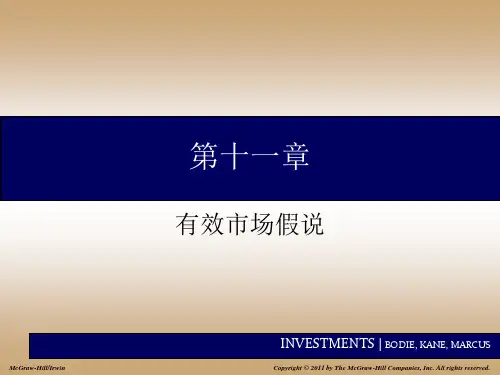
11-13
11.2.4 有效市场和投资组合管理
即使在完全有效的市场,理性实物投资组合 管理也是很重要的: •分散化:防范公司层面的风险; •合适的风险水平 •考虑税赋 •考虑年龄,不同的投资组合策略。
INVESTMENTS | BODIE, KANE, MARCUS
INVESTMENTS | BODIE, KANE, MARCUS
11-23
争论:
• 利润可以影响市场收益—市场收益的预言 者。
市场无效论—市场收益是可预测的,来源于非 常规收益的可预测性; 市场有效论—市场收益的可预测性来源于风险 溢价的可预测性;这些变量是市场风险溢价变动 的代理变量
INVESTMENTS | BODIE, KANE, MARCUS
11-27
INVESTMENTS | BODIE, KANE, MARCUS
11-28
11.4.5 强势有效检验:内幕消息
• Jaffe, Seyhun, Givoly和Palmon的研究表明内 幕人员能够通过交易本公司的股票来获利。 • 美国证券交易委员会(SEC)要求所有的内部 人员登记他们的交易活动。 • 但Seyhun的研究发现跟踪内部交易时徒劳的, 异常收益不足以弥补巨额交易费用。
11-24
11.4.4 半强式检验:市场异象
• 市盈率效应:低市盈率股票比高市盈率股票组合的收益 率高。 • 小公司效应(1月效应)。最大与最小公司组合的平均年收 益率差为8.59%,并且集中在1月份。 • 被忽略的公司效应和流动性效应 • 净市率效应:高净市率股票收益率高,与贝塔无关。 (法马和弗伦奇等)--是证券收益的有利预测工具,比 值高,则收益低 • 盈余报告后的价格漂移:有正意外收益的股票的累积异 常收益率在盈利信息公开之后会继续上涨,反之,会继 续下降,存在动量效应。这是有效市场不存在的。MARCUS INVESTMENTS | BODIE, KANE,
Behavior-Finance-复旦行为经济学
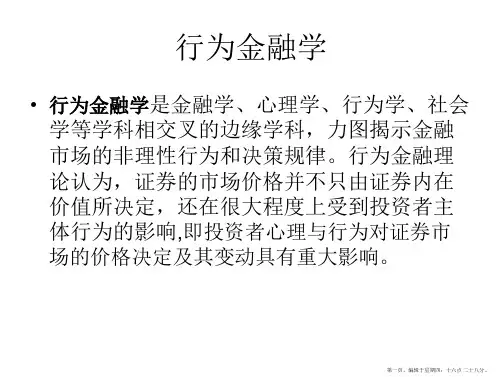
实证
• 孪生股权(twin shares)
1907年皇家荷兰(在美国和纽芬兰交易)
和壳牌运输(在英国交易)按60:40的基率 同意合并他们的股权,但仍保留为分离的实 体。如果价格等于基本价值,皇家荷兰的股 权价值应总是壳牌股权价值的1.5倍。 Froot and Dabora(1999)发现两者的股权价值 之比严重偏离1.5,而且,皇家荷兰按平价有 时35%被低估,有时15%被高估。
20 世纪70 年代法马(Fama) 对有效市场假说 ( EMH) 进行了正式表述,布莱克、斯科尔斯和莫
顿(Black-Scholes-Merton) 建立了期权定价模 型(OPM) ,至此,现代金融学已经成为一门逻辑
严密的具有统一分析框架的学科。
第四页,编辑于星期四:十六点 二十八分。
行为金融学理论简介
第三页,编辑于星期四:十六点 二十八分。
1952 年马克威茨(Markowitz) 发表了著名的论文 “portfolio selection”,建立了现代资产组合理 论,标志着现代金融学的诞生。
20 世纪60 年代夏普和林特纳(Sharp,Lintner) 建立并扩展了资本资产定价模型(CAPM)。
• ①投资者是有限理性的,投资者是会犯错误的。
• ② 在绝大多数时候,市场中理性和非理性的投 资者都是起作用的(而非标准金融理论中的非理 性投资者最终将被赶出市场,理性投资者最终决 定价格)。非理性对价格的影响是实质性的和长 期的。文献称之为“套利限制 (limits of arbitrage).
• 利用前景理论解释了不少金融市场中的异常现象:如股价 溢价之迷(equity premium puzzle)
复旦大学经济学院投资学原理
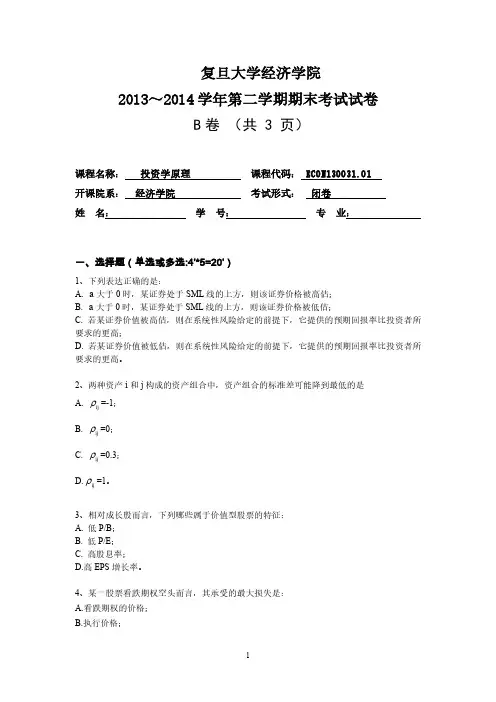
复旦大学经济学院2013~2014学年第二学期期末考试试卷B卷(共 3 页)课程名称:投资学原理课程代码: ECON130031.01开课院系:经济学院考试形式:闭卷姓名:学号:专业:一、选择题(单选或多选:4’*5=20’)1、下列表达正确的是:A. a大于0时,某证券处于SML线的上方,则该证券价格被高估;B.a大于0时,某证券处于SML线的上方,则该证券价格被低估;C. 若某证券价值被高估,则在系统性风险给定的前提下,它提供的预期回报率比投资者所要求的更高;D. 若某证券价值被低估,则在系统性风险给定的前提下,它提供的预期回报率比投资者所要求的更高。
2、两种资产i和j构成的资产组合中,资产组合的标准差可能降到最低的是ρ=-1;A.ijρ=0;B.ijρ=0.3;C.ijρ=1。
D.ij3、相对成长股而言,下列哪些属于价值型股票的特征:A. 低P/B;B. 低P/E;C. 高股息率;D.高EPS增长率。
4、某一股票看跌期权空头而言,其承受的最大损失是:A.看跌期权的价格;B.执行价格;C. 股价减去看跌期权价格;D.执行价格减去看跌期权价格。
5、根据影响期权的价值因素,下列表述错误的是:A.标的资产价格越高,看跌期权的价值越高;B.无风险利率越高,看涨期权价值越高;C.资产价格波动率越高,看涨期权价值越低;D.标的资产收益越越高,看涨期权价值越高。
二、名词(4’*5=20’)1、均值-方差准则2、经济附加值(EVA)3、债券收益率曲线4、可转换债券5、权的时间价值三、计算题(15’*2=30’)1.假定你利用两因素模型去确定一只股票的预期收益,两因素及假定的风险溢价见下表,无风险利率4.8%。
(1)如果定价合理,那么这只股票的预期收益是多少?(2)假定上表的因素风险溢价不正确,真正的因素风险溢价见下表,根据真正的风险溢价计算股票的预期收益。
(3)比较(1)和(2)的答案,根据假定的风险溢价的定价是低估还是高估了?2、已知一种面值为100元,息票率为6%的债券,每年付息一次,债券期限为3年,且到期收益率为6%,求该债券的久期、修正久期、凸度。
投资学(第四版)第十四章

第 投二 资节 组 合 现 理 代 论 证 券
二、资产组合理论
从图14-3中可以看出,多个证券构成的可行区域集是标准差-期望 收益率坐标系中的一个弹头型平面区域。在不允许卖空的情况下,组合 中每一证券的投资比例系数均为正,因此所形成的可行区域是闭合区域。 根据偏好收益、厌恶风险假设,我们可将可行区域的范围缩小,具 体分析如下: 在可行区域BERF内,包括了全部单个证券与全部组合的风险与收 益的坐标点。集合左边界BERF一段为最小方差边界,即在相同期望收 益的条件下,由投资风险(方差或标准差)最低的资产(证券)组合所 组成的曲线。 BF线段的下半部即BE段为无效率边界。因为在这一段,期望收益 越高,风险越低,投资者只会选择这一段的最高点,因为在最高点E上, 资产组合的期望收益最高,而风险却是最低的。 BF线段的上半部即ERF段为有效率边界,它包括全部有效资产组合。 有效资产组合的定义为:在相同风险情况下期望收益最大的组合,或者 在相同期望收益的情况下风险最低的组合。 因此,依据偏好收益投资者将范围缩小到上边界,依据厌恶风险投 资者将范围缩小到左边界,可行区域的左上边界即是有效边界。只有有 效边界上的点(代表一个投资组合)所代表的投资组合才是有效组合。 效率边界是凹性的即凸向纵轴。
投资学
(第四版)
王玉霞 编著
目 录
1 2 3 4 5
有效市场假说
现代证券投资组合理论 资本资产定价模型
证券投资组合管理的策略与操作 投资组合管理业绩评价
第 一 节 有 效 市 场 假 说
一、有效市场假说
市场有效性的基本假设是证券存在一种客观的均衡价值,股价已反 映所有已知的信息,且价格将趋向于均衡价值。这一假设意味着投资者 是理性的,其购买和出售行为将使证券价格趋向其内在价值,且调整到 均衡的速度,依赖于信息的可利用性和市场的竞争性。高度竞争且又有 众多掌握完全信息的参与者的市场,将会相当快速地将价格调整到均衡; 相反,只有很少参与者又只具有很不完全的信息流的市场,则可能要经 历一个相当缓慢的调整过程。 从一定意义上讲,市场有效性假设意味着资源配置的有效性和市场 运行的有效性,它是衡量证券市场信息分布、信息传递速度、交易的透 明度和规范程度的一个重要标志。证券市场的发展目标最终是造就一个 规范化的、高效率的、充满竞争的市场。只有市场有效,信息在价格中 得到迅速、充分反映,才能实现资本的有效配置和最优化。
复旦大学 研究生投资学讲义 CHPT13- Factor pricing model--CAPM
Chapter 13 Factor pricing modelFan LongzhenIntroduction•The consumption-based model as a complete answer to most asset pricing question in principle, does not work well in practice;•This observation motivates effects to tie the discount factor m to other data;•Linear factor pricing models are most popular models of this sort in finance;•They dominate discrete-time empirical work.Factor pricing models•Factor pricing models replace the consumption-based expression for marginal utility growth with a linear model of the form•The key question: what should one use for factors 11'+++=t t f b a m 1+t fCapital asset pricing model (CAPM)•CAPM is the model , is the wealth portfolio return.•Credited Sharpe (1964) and Linterner (1965), is the first, most famous, and so far widely used model in asset pricing.•Theoretically, a and b are determined to price any two assets, such as market portfolio and risk free asset.•Empirically, we pick a,b to best price larger cross section of assets;•We don’t have good data, even a good empirical definition for wealth portfolio, it is often deputed by a stock index;•We derive it from discount factor model by •(1)two-periods, exponential utility, and normal returns; •(2) infinite horizon, quadratic utility, and normal returns;•(3) log utility •(4) by seeing several derivations, you can see how one assumption can be traded for another. For example, the CAPM does not require normal distributions, if one is willing to swallow quadratic utility instead.wbR a m +=w RExponential utility, Normal distributions•We present a model with consumption only in the last period, utility is•If consumption is normally distributed, we have •Investor has initial wealth w, which invest in a set of risk-free assets with return and a set of risky assets paying return R.•Let y denote the mount of wealth w invested in each asset, the budget constraint is •Plugging the first constraint into the utility function, we obtain][)]([c eE c U E α−−=2/)()(22))((c c E e c U E σαα+−−=f R f y y w Ry R y c ff f ''+=+=yy R E y R y f f e c U E Σ++−−='2/)]('[2))((ααExponential utility, Normal distributions--continued •Applying the formula to market return itself, we have•The model ties price of market risk to the risk aversion coefficient.)()(2wf w R R R E ασ=−Quadratic value function, Dynamicprogramming-continued•(1) the value function only depends on wealth. If other variables enter the value function, m would depend on other variables. The ICAPM, allows other variables in the value function, and obtain more factors.•(other variable can enter the function, so long as they do not affect marginal utility value of wealth.)•(2) the value function is quadratic, we wanted the marginal value function is linear.Why is the value function quadratic•Good economists are unhappy about a utility function that have wealth in it.•Suppose investors last forever, and have the standard sort of utility function •Investors start with wealth which earns a random return andhave no other source of income;•Suppose further that interest rate are constant and stock returns are iid over time.•Define the value function as the maximized value of the utility function in this environment•∑∞=+=0)(j j t jt c u E U β0w w R {}11;);(..)()(''110,...,...,,max11==−==++∞=+∑++vtt tw tt t w t t j j t jt w w c c t R R c W R W t s c u E W V t t t t ωωβ,Why is the value function quadratic--continued•Without the assumption of no labor income, a constant interest rate, and I.I.d returns come in, the value maybe depend on the environment.For example, if D/P indicates returns would be high for a while, the investor might be happier and have a high value.•Value functions allow you to express an infinite-period problem as a two-period problem. Breaking up the maximization into the first period and the remaining periods, as follows•Or{}{}⎪⎭⎪⎬⎫⎪⎩⎪⎨⎧⎥⎦⎤⎢⎣⎡+=∑∞=+++++++11,...,,...,,,)()()(maxmax2121jjtjtwwccttwctcuEEcuWVttttttββ{}{})()()(1,max++=tttwctWVEcuWVttβLinearizing any model •Goal of linear model: derive variables that drive the discount factor; derive a linear relation between discount factor and these variables;•Following gives three standard tricks to obtain a linear model;Linearizing any model-Talyorexpansion•From •We have)(11++=ttfgm))())((('))((11111+++++−+≈ttttttttfEffEgfEgmComments on the CAPM and ICAPM•Is CAPM conditional or unconditional? Are the parameter changes as conditional information changes ?•The two-period quadratic utility-based deviation results in a conditional CAPM, since the parameters change over time.•The log utility CAPM hold both conditionally or unconditionally.•Should CAPM price options? The quadratic utility CAPM and log utility CAPM should apply to all payoffs.•Why linearize? Why not take the log utility model whichshould price any asset? Turn it into cannot price no normally distributed payoff and must be applied at short horizons.•it is simple to use regression to estimate in CAPM.•Now with GMM approach, nolinear discount factor model is easy to estimate.tt b a ,W R m /1=W t t t t R b a m 11+++=γβ,Comments on the CAPM and ICAPM---continued •Identify the factors: it is a art!。
复旦大学 研究生投资学讲义 CHPT10-Investment Styles
Investment Styles Fan LongzhenIntroduction•Overview of investment styles;•Empirical evidence on returns of small capitalization firms and value stocks;•How to identify investment styles of a mutual fund –Characteristic-based style analysis–Return-based style analysis•Style benchmarks•Why value stock outperform growth stocks;•Earning and price momentumTypes of investment styles •Growth investing–Primarily concerned with the earning component of the P/E ratio–Look for high growth rate•Value (non-growth) investing–Primarily concerned with the price component of theP/E ratio–Look for cheap stocks•Small cap investing (as opposed to large cap)–Looking for neglected stocks–Undervalued relative to large cap equitiesInvestment styles•Value:–low price/book; low P/E; utilities industry •Growth: high EPS Growth–high profitability; health & technology •Small capitalizationWhy style analysis?•Returns of stocks in one category (e.g. growth) behave quite differently from stocks in another category (e.g. value)•Style analysis facilities–Monitoring style characteristics;–Diversification and risk control;–Performance valuation•In September 2001, a total of 3271 domestic equity managers participated in the survey–962 identify themselves as value managers;–1124 identify themselves as growth managers.Returns of small capitalization stocks•Fama and French (1992)–Rank the stocks into ten deciles based on marketcapitalization every year;–Compute the average 1-year holding period return after portfolio formation.–Found small stocks have higher returns than big stocks(1963-1991)–Fama and French do a secondary sort by beta withineach size decile, and find that beta can not explain thereturns.Return of high/low book-to-market stocks•Fama and French (1992, Journal of finance)–Rank stocks into ten deciles based on book-to-market ratio every year;–Compute the average 1-year holding periodreturn after portfolio formation;–Value stocks have higher average returns thangrowth stocks.Morningstar Fund Analysis •Market capitalization classification–Step 1: rank all stocks based market capitalization •Top 5% of the stocks as large cap;•Next 15% of the stocks are medium cap;•Remaining 80% of the stocks as small cap.---step 2:assign a score of 3 for large-cap stocks, 2 for mid-cap stocks, and 1 for small-cap stocks.---step3: calculate the weighted average of the market cap score across all stocks in the fund.---Step 4: classification•If market cap score<1.5 small cap fund •If 1.5<market cap score<2.5 medium cap fund•If market score>2.5 large cap fund ⇒⇒⇒Morningstar Fund Analysis •Growth/value classification–Step 1: estimate mediam P/E and P/B ratio of the stocks in three market-cap groups;–Step 2 compute the P/E and P/B score for each stock: divide each stock’s P/E and P/B by the median P/E and median P/B (respectively) of the stock’s market-cap group;–Step 3 calculate the average P/E and P/B score for each fund: average P/E or P/B score is 1.–Step 4 combined score=P/E score +P/B score –Step5 classification•If combined score>2.25 growth fund •If 1.75<combined score<2.25 blend fund •If combined score<1.75 value fund ⇒⇒⇒Return-based style analysis •Based on multiple factor model:•Where =return on fund •= return on style benchmark k •How to estimate the style exposure?–Regression of fund I on the return of style benchmarks;•Unconstrained regression•Constrained regression ( )•Quadratic programming ( )i K iK i i i e F b F b F b R ~~...~~~2211++++=i R ~k F ~1=∑ik b 0,1>=∑ik ik b bStyle benchmark•Six style index–S&P 500/Barra growth and value–S&P midcap 400/Barra growth and value–S&P smallcap 600/Barra growth and value•Growth and value indexes are constructed by dividing the stocks in the corresponding basic index based on book-to-price ratio. Each company in the index is assigned to either the value or growth index so that the two style add up to the full index.•The growth and value indexes are constructed so that they have the same market capitalization. Since growth companies are bigger than value companies, there are many more companies in the value index than the growth index.。
2018年复旦大学经济学院博士研究生入学考试3759金融学考
2018年复旦大学经济学院博士研究生入学考试3759金融学考试大纲一、考试要求测试考生对投资学、公司金融学、货币银行学、国际金融学相关基础理论的掌握,以及运用基础理论分析和解释现实问题的能力。
二、考试大纲(一)投资学1、金融市场与机构(1)金融市场类别与金融工具(2)证券交易和监管机制(3)金融机构类型2、投资组合理论(1)风险与收益的度量(2)风险的偏好类型(3)均值方差分析(4)风险规避、风险分散的技术与方法(5)资产组合选择与管理(6)投资组合业绩评价3、均衡资本市场理论(1)资本资产定价模型(2)无套利定价理论及因素模型(3)有效市场假说及行为金融理论(4)证券收益的实证分析(包括:CAPM,APT,Fama-French多因子模型)4、普通股价值分析(1)收入资本化法与普通股价值分析(2)股息贴现模型(3)市盈率模型(4)股票投资的配置策略5、固定收益证券(1)债券的价格与收益(2)利率的期限结构(3)利率风险管理(4)信用风险和信用衍生产品6、远期、期货、期权与其它衍生证券(1)远期(2)期货(3)互换(4)期权定价理论和运用(包含无套利定价原理、二叉树定价、Black-Scholes定价模型等)(二)公司金融学1、资本预算(1)现金流与折现(2)投资决策方法比较(3)自由现金流(4)项目净现值(5)项目系统性风险(6)实物期权2、资本成本(1)普通股成本(2)债务成本(3)加权平均资本成本(WACC)3、资本结构(1)税收、破产成本与资本结构(2)权衡理论(3)管理者动机、信息不对称与资本结构(4)优序融资理论(5)目标资本结构4、股利政策(1)股利政策理论(2)股利政策实践(3)股份回购形式及优缺点5、营运资本管理(1)营运资本政策(2)现金和有价证券管理(3)应收账款管理(4)短期融资的方式、原则和策略6、收购与兼并(1)公司估值(2)并购动因及效应(3)杠杆收购(4)并购理论7、公司治理(1)代理问题(2)剥夺问题(3)公司治理机制(三)货币银行学1、金融体系概览(1)金融体系的构成和功能(2)金融结构的经济学分析2、货币与支付体系(1)货币的本质与职能(2)支付体系的历史演变(3)货币的层次与计量3、商业银行(1)商业银行业务及其创新(2)商业银行的风险管理(3)银行业的结构与竞争(4)金融监管的经济学分析(5)巴塞尔系列协议(6)商业银行的信用创造与收缩4、中央银行与货币供给(1)中央银行职能和业务(2)中央银行的资产负债表(3)存款创造与货币供给(4)货币供给的决定因素5、金融创新与金融监管(1)金融抑制与深化(2)金融创新的原理、分类及趋势(3)金融创新与金融监管(4)金融监管的国际趋势与中国实践6、货币政策(1)货币政策的目标和工具(2)货币政策操作和传导机制(3)货币政策效果(4)中国的货币政策框架7、货币理论(1)货币需求理论(2)货币政策与财政政策(3)通货膨胀与通货紧缩(4)理性预期与货币政策(四)国际金融学1、国际收支与国际收支平衡表(1)国际收支及国际收支平衡表(2)国际收支失衡及其调节2、外汇与汇率(1)国际金融市场(2)汇率与汇率制度3、汇率理论(1)汇率水平决定理论(包含购买力平价、利率平价、国际收支说、货币分析方法等理论与实证)(2)汇率制度选择理论(包含小国及大国条件下的蒙代尔-弗莱明模型、三元悖论等理论与实证)4、国际收支内外部均衡(1)内外部均衡的冲突(2)内外部均衡冲突的调节原则(3)内外部均衡调节的经典理论(4)开放经济下的政策搭配理论5、外汇管理(1)外汇直接管制(2)汇率制度选择(3)外汇储备管理(4)外汇市场干预(5)中国的汇率政策6、国际资本流动与金融危机(1)国际资本流动(2)债务危机、银行危机、货币危机以及次贷危机理论与实践7、国际金融协调与合作(1)国际货币协调的理论(2)国际货币协调的主要问题及制度安排(3)货币国际化的理论与实践(4)区域货币协调的理论与实践。
_有效市场假说
3. 内幕信息往往不是内幕
–信息是否有用取决于是否真实,以及有多少人知道。
4. 不应对有效市场理论过分教条,从而认为努力 研究是不必要的 • 结论:市场是有效的,但创造性的工作会有应 得的报酬!
中南财经政法大学中国投资研究中心
李建华 2006 版权所有
7- 28
有效市场理论的违背(异常)现象
• 异常现象
中南财经政法大学中国投资研究中心
李建华 2006 版权所有
7- 3
本章内容
• • • • 随机游走与有效市场 有效市场假说含义 有效市场假说的理论基础及实证基础 有效市场假说面临的挑战——行为金融初 步
中南财经政法大学中国投资研究中心
李建华 2006 版权所有
7- 4
股票价格的随机游走(random walk)
• 英国统计学家Kendall(1953)困惑
– 确定不了任何股价的可预测形式,股价的变化 是随机游走(Random walk)的——价格的变 化是随机的,且不可预测。 – 例子:
• 假设存在一个“准确的”模型,预测A股票价格3 天后将从20元/股涨至23元/股,若该预测信息是公 开的,则股票价格将发生怎样的变化? 3天后去买 能否获取超额利润? • 股价将瞬间上升到23元/股,3天后去买就失去了获 利机会,因为信息已经成为历史。
7- 8
有效市场假说(EMH)
• 有效市场假说的含义——Fama(1970)定义
– 有效市场是指这样的市场,其中的证券价格总是可以 即时充分地体现可获得信息变化的影响。
– 在极端状态下,认为不存在基于现在可获信息获取超 额利润的机会。 – 通俗讲,一个具有平常资质的投资者(个人、基金等) 都不能一直战胜市场。投资者每日进行的大量分析都 是在浪费资源,持有市场组合比主动理财要强得多。
- 1、下载文档前请自行甄别文档内容的完整性,平台不提供额外的编辑、内容补充、找答案等附加服务。
- 2、"仅部分预览"的文档,不可在线预览部分如存在完整性等问题,可反馈申请退款(可完整预览的文档不适用该条件!)。
- 3、如文档侵犯您的权益,请联系客服反馈,我们会尽快为您处理(人工客服工作时间:9:00-18:30)。
2.The Main Areas of Research
❖ 1970 review: weak-form tests; semi-strong form tests and strong-form tests
Returns ❖ 4.Cross-Sectional Return Predictability ❖ 5.Event Studies ❖ 6.Tests for Private Information ❖ 7.Conclusions
1. The Theme
❖ Strong version of market efficiency hypothesis: information and trading costs are 0
New tests remain suspicious but give us some new methodologies.
❖ Event studies are discussed next briefly. Its most advantage is allowing a break between market efficiency and equilibrium-pricing issues
Efficient Capital Markets:Ⅱ
The Journal of Finance, Vol 46,No. 5(Dec,1991)
By Eugene F.Fama
Menu
❖ 1.The Theme ❖ 2.The Main Areas of Research ❖ 3.Return Predictability: Time-Varying Expected
❖ 2nd obstacle: The joint-hypothesis, the market efficiency is not testable but must be jointly tested with some equilibrium model (some asset pricing models), the test results will become ambiguous among both aspects
❖ Nowadays the above three developed into the following respectively: (1)tests for return predictability (2)event studies (3)tests for private information
❖ Weaker version: prices at the point where marginal benefit do not exceed MC.
❖ 1st obstacle: The positive costs make the strong version hypothesis false but it could provide a good benchmark and avoid thtices of market professionals
❖ Therefore, the purpose of this paper is that the market efficiency literature should improve our ability to describe the time-series and cross-section behavior of security returns.
❖ The tests for private information problem are also shadowed by the joint-hypothesis problem
3. Return Predictability: Time varying Expected Returns
❖ Research on time-series predictability of stock returns. Recent tests consider the forecast power of D/P, E/P and term structure variables. They also examine returns for longer horizons, not only short term predictability checked by the early work
Does the joint –hypothesis problem make empirical work on asset-pricing models uninteresting?
❖ The answer is absolutely no. ❖ It has changed our views about the behavior of returns and
❖ Return predictability is most detailed and the evidence of this topic is most controversial. New works believe returns are predictable from past returns, dividend yields and term structure variables. It reject the old models but head onto the joint-hypothesis problem: Does return predictability reflect rational variation through time in expected returns or irrational deviations of price from fundamental value?
